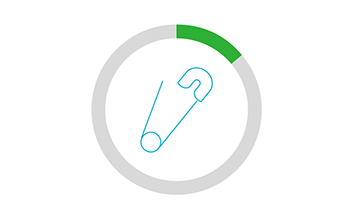Dental floss is something you probably don’t spend much time thinking about. While you probably have at least one tiny box of this waxed nylon thread somewhere in your house, what do you really know about it? Here are six interesting facts about floss.
Fascinating floss facts
1. Dental floss is a fairly recent invention
Along with jazz, New Orleans gave the world another gift — dental floss. A New Orleans dentist, Levi Spear Parmly, is credited with inventing it 1815, when he recommended a thin silk thread for cleaning between teeth. He later described it in his book A Practical Guide to the Management of the Teeth.
2. You probably need more floss than you think you do
The American Dental Association (ADA) recommends using 18 inches of floss daily. That’s almost 183 yards annually — nearly the length of two football fields!
3. Some people will floss with pretty much anything
When it comes to flossing, people like to get creative. Many people have used something other than floss between their teeth, according to an ADA survey found. And that “something” can be pretty alarming:
Not surprisingly, 42% say they’ve felt pain as a result of using these unusual items to remove things from their teeth. Thankfully, most of the people surveyed said they also knew that using these items to floss was a bad idea.
4. Some people won’t floss at all
According to the same survey, 8% of people never have worry about running out of dental floss — because they never use any. More than half of those people say they don’t floss because it’s too time consuming. Another reason people gave for not flossing was because they found it painful. And 9% said they won’t floss because it's because it’s gross and you can’t make me!
Another 44% of those surveyed admit they’ve exaggerated about how much they floss when asked by their dentist. (They lied.)
That’s a shame, because flossing does about 40% of the work required to remove decay-causing plaque from your teeth.
5. Flossing isn’t that difficult
The ADA recommends following these simple steps (PDF) to ensure that your flossing is effective:
• Wind the floss around your middle finger on one hand, and then the other.
• Hold the floss tightly between your thumbs and forefingers and insert it gently between your teeth.
• Curve the floss into a “C” shape against the side of your tooth.
• Keeping it pressed against your tooth, rub the floss gently up and down.
• Floss all your teeth — don’t forget to get behind your back teeth!
6. Dental floss is useful for more than teeth
Floss: It’s not just for teeth anymore. Believe it or not, dental floss is a versatile kitchen tool. Unused, unfavored floss works great for cutting cake, dough and soft cheeses, such as fresh mozzarella and goat cheese.
So when it comes to dental floss, remember that flossing daily is a vital part of your dental health routine. It protects you from cavities, gum disease and tooth loss. And it’s far less gross — and expensive — than a mouth full of cavities.
Seeing red when you brush and floss?
You can keep your gums healthy by improving your daily hygiene regimen and having a balanced diet.
Is your oral health endangering your lungs?
Poor oral hygiene can increase bacteria that can lead to respiratory disease.
Should you use essential oils?
Essential oils have been used as a natural medicine for centuries, but does that mean they’re safe?











